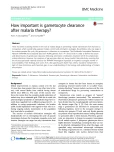How important is gametocyte clearance after malaria therapy?
There has been increasing interest in the role of malaria drugs in preventing malaria transmission from humans to mosquitoes, which would help augment malaria control and elimination strategies. Nevertheless, only one stage in the malaria parasite life cycle, the gametocyte, is infectious to mosquitoes. The Worldwide Antimalarial Resistance Network (WWARN) have analyzed data from 48,840 patients from 141 clinical trials in order to define the nature and determinants of gametocyte clearance following artemisinin combination treatment (ACT) for symptomatic malaria infections. However, the presence of gametocytes does not always predict their infectivity, meaning that the microscopy-based methods used by the WWARN investigators represent an imperfect surrogate marker of transmissibility. Their findings, that some ACTs clear gametocytes faster than others, should be interpreted in light of these limitations and important gaps in our understanding of the biology and epidemiology of malaria transmission.
Please see related article: https://bmcmedicine.biomedcentral.com/articles/10.1186/s12916-016-0621-7
Keywords:
Malaria P. falciparum Antimalarial Gametocytes Gametocyte clearance Artemisinin combination therapy
Autoři:
Harin A. Karunajeewa 1,2*; Ivo Mueller 1,3
Působiště autorů:
Walter and Eliza Hall Institute of Medical Research, 1G Royal Parade, Parkville, Vic 305 , Australia.
1; Western Centre for Health Research and Education, Western Health, Melbourne, Australia.
2; Malaria: Parasites & Hosts Unit, Institut Pasteur, Paris, France.
3
Vyšlo v časopise:
BMC Medicine 2016, 14:93
Kategorie:
Commentary
prolekare.web.journal.doi_sk:
https://doi.org/10.1186/s12916-016-0641-3
© 2016 The Author(s). Open Access This article is distributed under the terms of the Creative Commons Attribution 4.0 International License (http://creativecommons.org/licenses/by/4.0/), which permits unrestricted use, distribution, and reproduction in any medium, provided you give appropriate credit to the original author(s) and the source, provide a link to the Creative Commons license, and indicate if changes were made. The Creative Commons Public Domain Dedication waiver
(http://creativecommons.org/publicdomain/zero/1.0/) applies to the data made available in this article, unless otherwise stated.
The electronic version of this article is the complete one and can be found online at: https://bmcmedicine.biomedcentral.com/articles/10.1186/s12916-016-0641-3
Souhrn
There has been increasing interest in the role of malaria drugs in preventing malaria transmission from humans to mosquitoes, which would help augment malaria control and elimination strategies. Nevertheless, only one stage in the malaria parasite life cycle, the gametocyte, is infectious to mosquitoes. The Worldwide Antimalarial Resistance Network (WWARN) have analyzed data from 48,840 patients from 141 clinical trials in order to define the nature and determinants of gametocyte clearance following artemisinin combination treatment (ACT) for symptomatic malaria infections. However, the presence of gametocytes does not always predict their infectivity, meaning that the microscopy-based methods used by the WWARN investigators represent an imperfect surrogate marker of transmissibility. Their findings, that some ACTs clear gametocytes faster than others, should be interpreted in light of these limitations and important gaps in our understanding of the biology and epidemiology of malaria transmission.
Please see related article: https://bmcmedicine.biomedcentral.com/articles/10.1186/s12916-016-0621-7
Keywords:
Malaria P. falciparum Antimalarial Gametocytes Gametocyte clearance Artemisinin combination therapy
Zdroje
1. World Health Organization. World Malaria Report 2015. Geneva: WHO; 2015.
2. MalERA Consultative Group on Drugs. A research agenda for malaria eradication: drugs. PLoS Med. 2011;8(1):e1000402.
3. Young JA, Fivelman QL, Blair PL, de la Vega P, Le Roch KG, Zhou Y, Carucci DJ, Baker DA, Winzeler EA. The Plasmodium falciparum sexual development transcriptome: a microarray analysis using ontology-based pattern identification. Mol Biochem Parasitol. 2005;143(1):67–79.
4. White NJ, Ashley EA, Recht J, Delves MJ, Ruecker A, Smithuis FM, Eziefula
AC, Bousema T, Drakeley C, Chotivanich K, et al. Assessment of therapeutic responses to gametocytocidal drugs in Plasmodium falciparum malaria. Malar J. 2014;13 : 483.
5. Graves PM, Gelband H, Garner P. Primaquine or other 8-aminoquinoline for reducing P. falciparum transmission. Cochrane Database Syst Rev. 2014;6:CD008152.
6. Delves M, Plouffe D, Scheurer C, Meister S, Wittlin S, Winzeler EA, Sinden RE, Leroy D. The activities of current antimalarial drugs on the life cycle stages of Plasmodium: a comparative study with human and rodent parasites. PLoS Med. 2012;9(2):e1001169.
7. World Health Organization. Guidelines for the treatment of malaria. 3rd ed. Geneva: WHO; 2015.
8. WWARN Gametocyte Study Group. Gametocyte carriage in uncomplicated Plasmodium falciparum malaria following treatment with artemisinin combination therapy: a systematic review and meta-analysis of individual patient data. BMC Med. 2016;14 : 79.
9. White NJ. Primaquine to prevent transmission of falciparum malaria. Lancet Infect Dis. 2013;13(2):175–81.
10. Beavogui AH, Djimde AA, Gregson A, Toure AM, Dao A, Coulibaly B, Ouologuem D, Fofana B, Sacko A, Tekete M. Low infectivity of Plasmodium falciparum gametocytes to Anopheles gambiae following treatment with sulfadoxine-pyrimethamine in Mali. Int J Parasitol. 2010;40(10):1213–20.
11. Kone A, van de Vegte-Bolmer M, Siebelink-Stoter R, van Gemert GJ, Dara A, Niangaly H, Ouologuem D, Fofana B, Sacko A, Tekete M. Sulfadoxinepyrimethamine impairs Plasmodium falciparum gametocyte infectivity and Anopheles mosquito survival. Int J Parasitol. 2010;40(10):1221–8.
12. Goncalves BP, Tiono AB, Ouedraogo A, Guelbeogo WM, Bradley J, Nebie I, Siaka D, Lanke K, Eziefula AC, Diarra A, et al. Single low dose primaquine to reduce gametocyte carriage and Plasmodium falciparum transmission after artemether-lumefantrine in children with asymptomatic infection: a randomised, double-blind, placebo-controlled trial. BMC Med. 2016;14 : 40.
13. Johnston GL, Gething PW, Hay SI, Smith DL, Fidock DA. Modeling within-host effects of drugs on Plasmodium falciparum transmission and prospects for malaria elimination. PLoS Comput Biol. 2014;10(1):e1003434.
Článok vyšiel v časopise
BMC Medicine

2016 Číslo 93
- Metamizol jako analgetikum první volby: kdy, pro koho, jak a proč?
- Nejasný stín na plicích – kazuistika
- Masturbační chování žen v ČR − dotazníková studie
- Antidepresivní efekt kombinovaného analgetika tramadolu s paracetamolem
- Flibanserin není ženská Viagra
Najčítanejšie v tomto čísle
